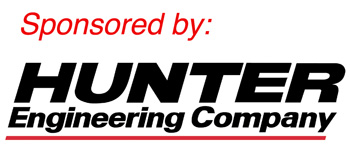 The thrust angle is an imaginary line drawn perpendicular to the rear axle’s centerline. It compares the direction that the rear axle is aimed with the centerline of the vehicle. It also confirms if the rear axle is parallel to its front axle and that the wheelbase on both sides of the vehicle is the same. It is one of the most important diagnostic angles during an alignment.
The thrust angle is an imaginary line drawn perpendicular to the rear axle’s centerline. It compares the direction that the rear axle is aimed with the centerline of the vehicle. It also confirms if the rear axle is parallel to its front axle and that the wheelbase on both sides of the vehicle is the same. It is one of the most important diagnostic angles during an alignment.
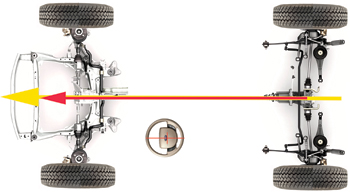 To measure the thrust angle on a vehicle, you have to perform a four-wheel alignment. Even if the rear axle is non-adjustable, you need to take rear axle readings to properly align the front suspension.
To measure the thrust angle on a vehicle, you have to perform a four-wheel alignment. Even if the rear axle is non-adjustable, you need to take rear axle readings to properly align the front suspension.
A thrust condition exists when the rear individual toe is not equal. The thrust angle of a vehicle can be generated by two conditions or angles. This makes it difficult for some technicians to properly diagnosis the problem. 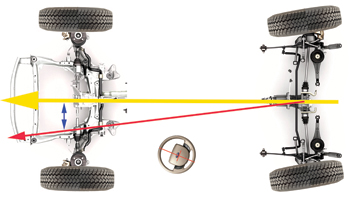 First, the thrust angle could be generated by the angle of the axle or a misaligned rear suspension cradle that can change the toe angles. Also, a thrust angle can be generated by rear toe settings that are independent of the axle angle or implied axle angle.
First, the thrust angle could be generated by the angle of the axle or a misaligned rear suspension cradle that can change the toe angles. Also, a thrust angle can be generated by rear toe settings that are independent of the axle angle or implied axle angle.
The thrust angle can determine the straight-ahead position of the front wheels. So ignoring this angle can undermine even the most accurately 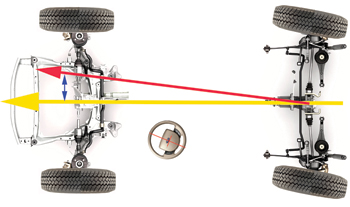 aligned front suspension. It can result in a crooked steering wheel as the front wheels steer to align themselves with the desired direction of the vehicle. Also, a misaligned thrust angle can cause the vehicle to handle differently when turning one direction versus the other.
aligned front suspension. It can result in a crooked steering wheel as the front wheels steer to align themselves with the desired direction of the vehicle. Also, a misaligned thrust angle can cause the vehicle to handle differently when turning one direction versus the other.
RWD VEHICLES WITH LEAF SPRINGS
Most rear-wheel drive cars and trucks with rear leaf spring suspensions 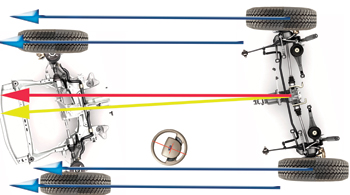 don’t have adjustments built into the suspension. But, the thrust line is a very important angle that can help you diagnose other problems.
don’t have adjustments built into the suspension. But, the thrust line is a very important angle that can help you diagnose other problems.
If the rear live axle vehicle has a greater than normal angle, thrust angle is an indication that the axle has shifted or the mounting points on the frame have shifted.
To get a better picture of the damage, look at the setback of the front wheels. Setback is a diagnostic angle 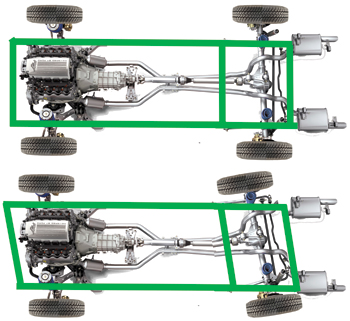 that measures the difference in distances between the centers of the front wheels. Differences in the setback angle can indicate damage in the frame or within components like control arms and bushings. Take a closer look at caster angles from side to side to see if there is a larger problem.
that measures the difference in distances between the centers of the front wheels. Differences in the setback angle can indicate damage in the frame or within components like control arms and bushings. Take a closer look at caster angles from side to side to see if there is a larger problem.
A setback and thrust angle misalignment could be an indication of frame damage. If the vehicle has suffered a recent collision that was offset, the frame may be suffering from a condition known as a “diamond frame.” This occurs when one side rail shifts in relationship to the other side rail. On a vehicle with an independent front suspension and a rear live-axle, the shifted rails will cause the front suspension to have an increased setback and thrust angle. This is caused by the mounting points of the suspension moving.
Another piece of diagnostic information to look at is the ride height. On rear suspensions with leaf springs, the leaves of the springs can become damaged and can change the ride height and the position of the axle.
One remedy for this problem is a plate that can go between the axle and springs, and allows some fore and aft repositioning of the axle to equalize rear toe readings on both sides.
Install the plate on the side of the vehicle which will help to equalize ride height. Installation of this kit may change ride height 1/2 inch. If ride height is negligible, then installation should be done on the right side for leaf springs above the axle (left side for leaf springs below the axle) to account for road crown.
Axle housings can become bent from impacts. If you see an axle with a difference in toe greater than .50º look at the axle for possible damage.
Rocking the Cradle
More and more automakers are offering all-wheel-drive on an increasing number of vehicles from small SUVs to compact sedans. On these vehicles they are mounting the differential and suspension components of a cradle that may only connect to the uni-body in four to six locations. While this may make for easy assembly, it makes the alignment technician’s job more difficult.
When aligning these types of vehicles, pay attention to rear wheel setback and the thrust angle. These diagnostic angles can help you determine if the cradle or suspension components are damaged. Most thrust angle problems on these suspensions can be resolved with toe adjustments. But, if the cradle has shifted, you may quickly run out of adjustment on the toe links.









